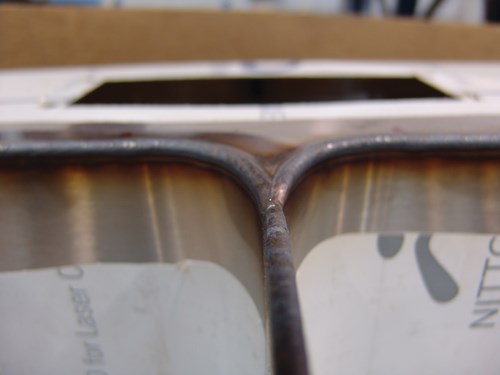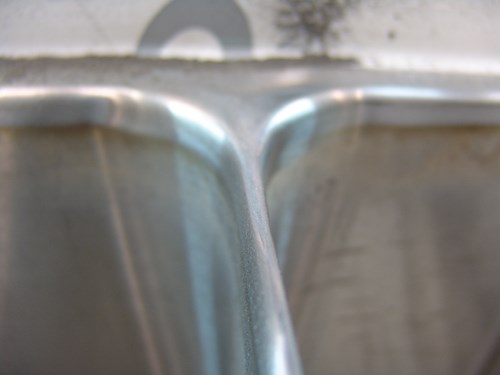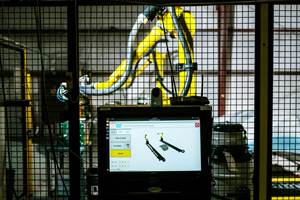Raising the Bar on Polishing
Glastender builds bar equipment faster thanks to AM Machinery, Autopulit.
Walk into any fine restaurant or bar and the things you notice are obvious: expensive décor, fine china, cloth linens and an extensive wine list.
What is often overlooked—the workhorse of many great establishments—is the equipment behind the bar that keeps drinks and ice cold and the glasses and silverware clean and spotless.
No one notices the sink, unless perhaps, you are Mark Norris from Glastender, the Saginaw, Michigan-based manufacturer of a full line of underbar equipment, including underbar sinks, glass washers, cocktail stations, back bar refrigeration and complete beer systems.
Norris is vice president of operations for the family-owned firm, which was founded in 1969 by Jon Hall, who invented the world’s first automatic rotary glass washer that saved space and eliminated wasted steps for bartenders running dirty glasses back and forth to the kitchen or hand-washing them one by one.
Nearly all of Glastender’s high-end commercial food service products are made from stainless steel. The units are laser cut or punched from stainless steel sheets, deburred, bent, welded, finished, assembled and then shipped out the door for the next happy hour to begin.
“It’s a very extended process that some people never realize goes into a piece of equipment like that,” Norris says. “It takes time, but our customers always seem to want things very quickly, because our products are often the final items that go into a new restaurant or bar.”
Crunch Time
That puts Glastender on a time crunch, something that happens constantly at its factory but often can’t be rushed because of the hands-on craftsmanship of welders and assemblers who put all of the pieces together perfectly before the entire bar package gets shipped.
In the past, the grinding operators would spend several hours on a three- or four-bowl sink section to knock down the edges and smooth out the welding seams. But Norris went looking for a speedier alternative and found one.
“We were robotically welding the underbar sinks, and then hand grinding them to get the finish we wanted,” he says. “That was taking about 40 to 45 minutes for each bowl, and when you have three or four of them, it cost us a lot of money in labor.”
The bowls are stamped out from a piece of sheet metal, then a top wrap is formed and the two are welded together. From there, the assembly is welded into a work service, which could be a sink section or portable bar.
Thus began the process of sanding and grinding the numerous welds to get a clean finish. The unit was put into a vertical machining center to help clean up the service even more, and although the result was a shiny new underbar unit, the considerable time spent was eating into production schedules and margins.
“We just came to the conclusion that we needed to get better at this,” Norris says.
Automated Process
The search for an automated sanding, grinding and finishing system was part of an overall plan by Glastender to automate its entire process to ensure consistent quality, improve safety, save money and speed up production, in order to meet customer installation dates.
Norris admits that his production system for finishing was not in the best shape 15 to 18 years ago. There were no standards on processes, no scheduling systems and no formal plans in place to streamline operations or provide quick turnaround to customers wanting products as fast as possible.
Glastender revolutionized its manufacturing approach when it eliminated departmentalization of employees by skill set, and grouped them, instead, into product teams. A group of employees would take products through the entire process of deburring, bending, welding, finishing, assembling and shipping in order to experience the processes as a team, and thus be able to identify improvements along the way.
So the refrigeration team worked one product line, the glass washers another, the underbar team another, and down the line. As the teams got to know and understand the overall processes, efficiencies began to materialize, including a better way to sand and grind the welds.
“We punch or laser cut about 28,000 parts a week, and we don’t set anything on a shelf, we are just-in-time,” Norris says. “Four days after a sheet of stainless is delivered from our automated raw material warehouse, those parts are in our shipping department in the form of fully assembled product ready to ship to the customer.”
Safety Conscious
But Norris wanted to speed up production without jeopardizing employee safety, a serious priority for Glastender. In fact, in 2014, the Michigan Occupational Safety and Health Administration once again recognized Glastender for excellence in workplace safety and health, a distinction the company has received annually since 2011.
“They have created a culture where protecting workers is a top priority,” says MIOSHA Director Martha Yoder, “They recognize that a safe workplace provides the foundation for a productive workplace.” She says Glastender’s facility has an excellent system in place, incorporating each of the award’s requirements: hazard anticipation and detection; hazard prevention and control; planning and evaluation; administration and supervision; safety and health training; management leadership; and employee participation.


Before and after the Autopulit machine's work on weld seams.
Some of Glastender’s recent improvements include increased employee involvement, setting a numerical goal for submission of action items designed to report to management with suggestions for safety and health improvement and incentive programs that include excellent methods of reinforcing positive employee safety and health actions.
AM Machinery
The same drive toward constant improvement led Glastender to AM Machinery Sales, Inc. Sales in Warminster, Pennsylvania, where Norris worked with company president Tony McCue to find a solution to speed up the finishing process.
AM Machinery has been involved in the metal finishing business for more than 25 years with products that offer solutions for deburring, belt grinding, polishing, buffing and microfinishing. It is the importer of Autopulit automatic and CNC machines for polishing, deburring and microfinishing, KBM stroke sanding machines, Loewer deburring, edge rounding and small part deburring machines, NS tube grinding and notching machines.
AM Machinery is located in historic Bucks County, about 45 minutes north of Philadelphia. McCue said its corporate headquarters were designed and built to allow our customers to witness first-hand the quality of its machines with a combined office space, warehouse and showroom facilities in one location.
Norris tasked McCue with helping him expedite the production process, which was aggressive by any stretch of the imagination. The lead time used to be six to eight weeks from order placement to shipping, but Norris wanted to get that period down to a few days, or a week at most.
“This was going to have a dramatic effect on their operations,” McCue says. “We needed to get it right for them.”
The problem was that because Glastender made such a variety of products of various shapes and sizes, there wasn’t an off-the-shelf solution to take care of the sanding and grinding.
But McCue has worked with his Spanish supplier, Autopulit, for many years, and knew that the right configuration—and plenty of testing—would give Norris and Glastender the result they wanted.
“It doesn’t matter if the application is making a door knob, an aerospace component or the front end of a truck, I know that we can get a polishing machine tuned just right for them to use,” he says.
Right Combination
With experience with Autopulit on past projects ranging from polishing brush guards for trucks to finishing aerospace components, McCue was confident they could quickly develop a solution for Norris and his team.
“We have built many different machines that grind and polish, so the challenge was to find the best solution for producing Glastender parts,” he says. “The machines’ capabilities are almost unlimited, so you have a vast array of technology to choose from, such as the ability to follow the changing contours of any given part with a floating head.”

The Autopulit machine makes compensation changes for wheel wear, feed rate per minute and the speed rate.
In addition, the machines have the capability to compensate for the wear in buffing applications, thereby simplifying their day-to-day use. By automatically adjusting the many parameters involved—such as feed speeds and the pressure applied—it reduces the time setting up and running the machine, and gets the maximum life from the consumables.
On the Fly
Essentially, the machine needed to make “on the fly” compensation changes for the wheel wear, the feed rate per minute and the speed rate, all at the same time.
“What’s great is that if you have 500 parts to work on, you might wear a 14-inch diameter buff to eight inches or so,” McCue says. “And the next day, when you need to do 200 more pieces, you can still use the 8-inch buff and get the same results. The system adjusts itself based on the new size, and reprograms itself to start the new job.”
The partnership between AM Machinery and Autopulit to get the Glastender machine ready included Norris traveling to Spain to check out the progress of the equipment and to see the machine in action.
One thing that everyone noticed right away is that nearly every bowl in the Glastender’s underbars was different, as the handmade parts often took on slight variations in welds and fittings from one to the next.
“Each bowl is a snowflake,” Norris says. “Even though we do things to reduce the heat when welding, there are still going to be inconsistencies in every bowl. What we were looking for was the Autopulit machine to make up for those inconsistencies and give us the same result.”
McCue and his team at AM Machinery were experienced in working with materials that might warp due to the heat produced by some grinding methods. Another customer AM Machinery was working with was using a thinner steel material, and warping would occur if the grinding was too hard and building up heat onto the material.
“You will burn it if you grind too hard,” he says. “When you seam weld, there is already going to be a warping. It looks like a shoreline, and near the edges, the warping could be as much as an inch. It’s wavy, and it’s on both sides.”
McCue and his staff have overcome heat difficulties before. Every aspect of the machine is considered when dealing with these challenges, he said, and everything from cooling the fixtures to adjusting placement of ventilation ducts are used to reduce heat or avoid it all together.
For example, another customer had hoped to finish 10 of its parts per hour with the new machine. McCue says that the Autopulit machine could do a triple sink with drain boards added on each side—numerous welds for the bowls and rims, plus the side boards—in just under six minutes to meet the customer’s goal.
To gain this additional speed, several steps were taken. Beyond fine tuning of the programming to be sure the travel speed and pressure applied were perfect, the areas requiring the most work were cooled with a low volume air to avoid discoloration of the surface. That attention to detail is what has made the collaboration between AM Machinery and Autopulit a success.
“It worked beautifully,” McCue says. “That little bit of airflow coming up through the fixture is what made all the difference in eliminating the discoloration. It was a very smart engineering solution.”
Flexibility
When Norris visited the prototypes in Spain, he quickly saw that the Autopulit machines were far more flexible than he hoped, lacking the limitations of other machines.
The total process, from Glastender sending samples to Barcelona for Autopulit to test the weld grinds, to the finished machine being ready to ship to the U.S., took between nine months and a year to complete, Norris says.
“We had a lot of discussions with Autopulit, and then we just had to let its engineering team wrap their minds around what we needed and let them build it,” Norris says. “When we went to see the machine prototype, my own engineer and I spent about a week with them in Spain offering ideas and helping fine-tune the process as much as we could.”
A second visit a few months later made Norris and his team smile as they watched parts run off the machine and meet their expectations for both targeted cycle times and quantity.
“The second visit was more of a party because it was really what we wanted to see,” he says. “Autopulit did an excellent job of incorporating our needs into the machine. It was great to see.”
Easy Setup
The machine was easy to set up once it arrived at the Glastender factory, Norris says, and it was easy to train employees on how to use it. The programmer spends a lot of time making sure the parameters of each product needing to be smoothed are entered into the software, and the machine does all of the work with very little human oversight.
When AM Machinery quotes jobs for grinding or buffing machines, it knows that when the equipment is installed, it can replace five people manually doing the same job, and the company uses that fact to emphasize the return on investment to its customers.
It’s no surprise when one of McCue’s customers can pay for the new machine in less than a year.
“Having to do this manually is hard work,” he says. “So either a company will continually turn over employees doing this work because it is so hard and tiring, or they have people that they are paying a pretty penny because it is such demanding work.”
The biggest change for Glastender—besides letting go of the high manual labor costs—is that it was able to improve its just-in-time lean manufacturing approach while eliminating millions of dollars in inventory just sitting around the factory.
Going from weeks to start and finish an underbar setup to just four days has improved Glastenders’ process flow and made its customers (especially those that order custom jobs at the last minute) a lot more satisfied.
McCue says working with Glastender and helping it improve its manufacturing process was icing on the cake because he admires the company so much. “The biggest thing I came away with was how nice the Glastender people were, and I saw how well they treated their employees,” he says. “This machine helped the manufacturing process and it also helped the employees, too. They were just great people to work with and be around.”
For information on AM Machinery, call 215-293-0333, or visit ammachinerysales.com
Originally published in the July 2015 issue.
Related Content
AI-Powered Robotic Solutions Support High-Mix Finishing
AI startup offers automation innovations for high-mix, high-variability, manual surface finishing applications.
Read MoreUnderstanding Shot Peening
A look inside shot peening — a process of “hammering” of work pieces with precisely defined blast media.
Read MoreVulkan Blast Shot Technology
Vulkan Blast Shot Technology is a pioneer in the stainless steel abrasives market.
Read MoreWall Colmonoy Hires Business Development Manager, Surfacing Products
Wall Colmonoy welcomes Josh Gardner as its business development manager of surfacing products.
Read MoreRead Next
Episode 45: An Interview with Chandler Mancuso, MacDermid Envio Solutions
Chandler Mancuso, technical director with MacDermid Envio discusses updating your wastewater treatment system and implementing materials recycling solutions to increase efficiencies, control costs and reduce environmental impact.
Read MoreEducation Bringing Cleaning to Machining
Debuting new speakers and cleaning technology content during this half-day workshop co-located with IMTS 2024.
Read MoreA ‘Clean’ Agenda Offers Unique Presentations in Chicago
The 2024 Parts Cleaning Conference, co-located with the International Manufacturing Technology Show, includes presentations by several speakers who are new to the conference and topics that have not been covered in past editions of this event.
Read More





















